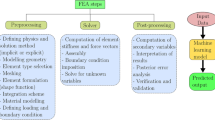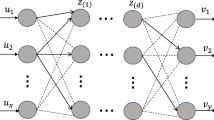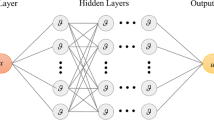Abstract
We introduce an optimized physics-informed neural network (PINN) trained to solve the problem of identifying and characterizing a surface breaking crack in a metal plate. PINNs are neural networks that can combine data and physics in the learning process by adding the residuals of a system of partial differential equations to the loss function. Our PINNs is supervised with realistic ultrasonic surface acoustic wave data acquired at a frequency of 5 MHz. The ultrasonic surface wave data is represented as a deformation on the top surface of a metal plate, measured by using the method of laser vibrometry. The PINN is physically informed by the acoustic wave equation and its convergence is sped up using adaptive activation functions. The adaptive activation function uses a trainable hyperparameter, which is optimized to achieve the best performance of the network. The adaptive activation function changes dynamically, involved in the optimization process. The usage of the adaptive activation function significantly improves the convergence, evidently observed in the current study. We use PINNs to estimate the speed of sound of the metal plate, which we do with an error of 1%, and then, by allowing the speed of sound to be space dependent, we identify and characterize the crack as the positions where the speed of sound has decreased. Our study also shows the effect of sub-sampling of the data on the sensitivity of sound speed estimates. More broadly, the resulting model shows a promising deep neural network model for ill-posed inverse problems.














Similar content being viewed by others

References
Acoustic properties for metals in solid: From NDT Resource Center. https://www.nde-ed.org/GeneralResources/MaterialProperties/UT/ut_matlprop_metals.htm. Accessed 20 Nov 2019
Alipanahi, B., Delong, A., Weirauch, M.T., Frey, B.J.: Predicting the sequence specificities of DNA-and RNA-binding proteins by deep learning. Nat. Biotechnol. 33(8), 831 (2015)
Baydin, A.G., Pearlmutter, B.A., Radul, A.A., Siskind, J.M.: Automatic differentiation in machine learning: a survey. J. Mach. Learn. Res. 18(153), 1–43 (2018)
Blackshire, J.L.: Ultrasonic scattering from complex crack morphology features. In: 2012 IEEE International Ultrasonics Symposium, pp. 248–251. IEEE (2012)
Blackshire, J.L.: Enhanced damage characterization using wavefield imaging methods. In: AIP Conference Proceedings, vol. 1806, p. 090008. AIP, College Park (2017)
Blackshire, J.L., Sathish, S.: Near-field ultrasonic scattering from surface-breaking cracks. Appl. Phys. Lett. 80(18), 3442–3444 (2002)
Carcione, J.M.: Wave Fields in Real Media: Wave Propagation in Anisotropic, Anelastic, Porous and Electromagnetic Media, vol. 38. Elsevier, Amsterdam (2007)
Dawson, A.J., Michaels, J.E., Michaels, T.E.: Isolation of ultrasonic scattering by wavefield baseline subtraction. Mech. Syst. Signal Process. 70, 891–903 (2016)
Goyal, P., Dollár, P., Girshick, R., Noordhuis, P., Wesolowski, L., Kyrola, A., Tulloch, A., Jia, Y., He, K.: Accurate, large minibatch SGD: Training imagenet in 1 hour. arXiv preprint arXiv:1706.02677 (2017)
Jagtap, A.D., Kawaguchi, K., Karniadakis, G.E.: Adaptive activation functions accelerate convergence in deep and physics-informed neural networks. J. Comput. Phys. 404, 109136 (2020)
Kingma, D.P., Ba, J.: Adam: A method for stochastic optimization. arXiv preprint arXiv:1412.6980 (2014)
Krizhevsky, A., Sutskever, I., Hinton, G.E.: Imagenet classification with deep convolutional neural networks. Advances in Neural Information Processing Systems, pp. 1097–1105. MIT Press, Cambridge (2012)
Lake, B.M., Salakhutdinov, R., Tenenbaum, J.B.: Human-level concept learning through probabilistic program induction. Science 350(6266), 1332–1338 (2015)
Nielsen, M., Lund, O.: Nn-align. an artificial neural network-based alignment algorithm for MHC class II peptide binding prediction. BMC Bioinform. 10(1), 296 (2009)
Pedregosa, F., Varoquaux, G., Gramfort, A., Michel, V., Thirion, B., Grisel, O., Blondel, M., Prettenhofer, P., Weiss, R., Dubourg, V., Vanderplas, J., Passos, A., Cournapeau, D., Brucher, M., Perrot, M., Duchesnay, E.: Scikit-learn: machine learning in Python. J. Mach. Learn. Res. 12, 2825–2830 (2011)
Pohl, J., Mook, G.: Laser-vibrometric analysis of propagation and interaction of Lamb waves in CFRP-plates. CEAS Aeronaut. J. 4(1), 77–85 (2013)
Raissi, M., Karniadakis, G.E.: Hidden physics models: machine learning of nonlinear partial differential equations. J. Comput. Phys. 357, 125–141 (2018)
Raissi, M., Perdikaris, P., Karniadakis, G.E.: Machine learning of linear differential equations using gaussian processes. J. Comput. Phys. 348, 683–693 (2017)
Raissi, M., Perdikaris, P., Karniadakis, G.E.: Physics-informed neural networks: a deep learning framework for solving forward and inverse problems involving nonlinear partial differential equations. J. Computat. Phys. 378, 686–707 (2019)
Raissi, M., Wang, Z., Triantafyllou, M.S., Karniadakis, G.E.: Deep learning of vortex-induced vibrations. J. Fluid Mech. 861, 119–137 (2019)
Rudy, S.H., Brunton, S.L., Proctor, J.L., Kutz, J.N.: Data-driven discovery of partial differential equations. Sci. Adv. 3(4), e1602614 (2017)
Tian, Z., Yu, L.: Lamb wave frequency-wavenumber analysis and decomposition. J. Intell. Mater. Syst. Struct. 25(9), 1107–1123 (2014)
Wang, Y.E., Wei, G.Y., Brooks, D.: Benchmarking TPU, GPU, and CPU platforms for deep learning. arXiv preprint arXiv:1907.10701 (2019)
Acknowledgements
The work is supported by DARPA-AIRA Grant HR00111990025. This research was conducted using computational resources and services at the Center for Computation and Visualization, Brown University. KS would like to acknowledge Dr. Helen Kershaw from CCV, Brown University for providing the help and feedback at various stages of the research especially for problems concerning to the computation.
Author information
Authors and Affiliations
Corresponding author
Ethics declarations
Conflict of interest
The authors declare that they have no conflict of interest.
Additional information
Publisher's Note
Springer Nature remains neutral with regard to jurisdictional claims in published maps and institutional affiliations.
Electronic supplementary material
Below is the link to the electronic supplementary material.
Appendices
Appendix A: Python Code Snippet of PCA Process

Appendix B: PCA Filtered Data Acquired at \(0^{\circ }\) and \(90^{\circ }\)
Rights and permissions
About this article
Cite this article
Shukla, K., Di Leoni, P.C., Blackshire, J. et al. Physics-Informed Neural Network for Ultrasound Nondestructive Quantification of Surface Breaking Cracks. J Nondestruct Eval 39, 61 (2020). https://doi.org/10.1007/s10921-020-00705-1
Received:
Accepted:
Published:
DOI: https://doi.org/10.1007/s10921-020-00705-1





